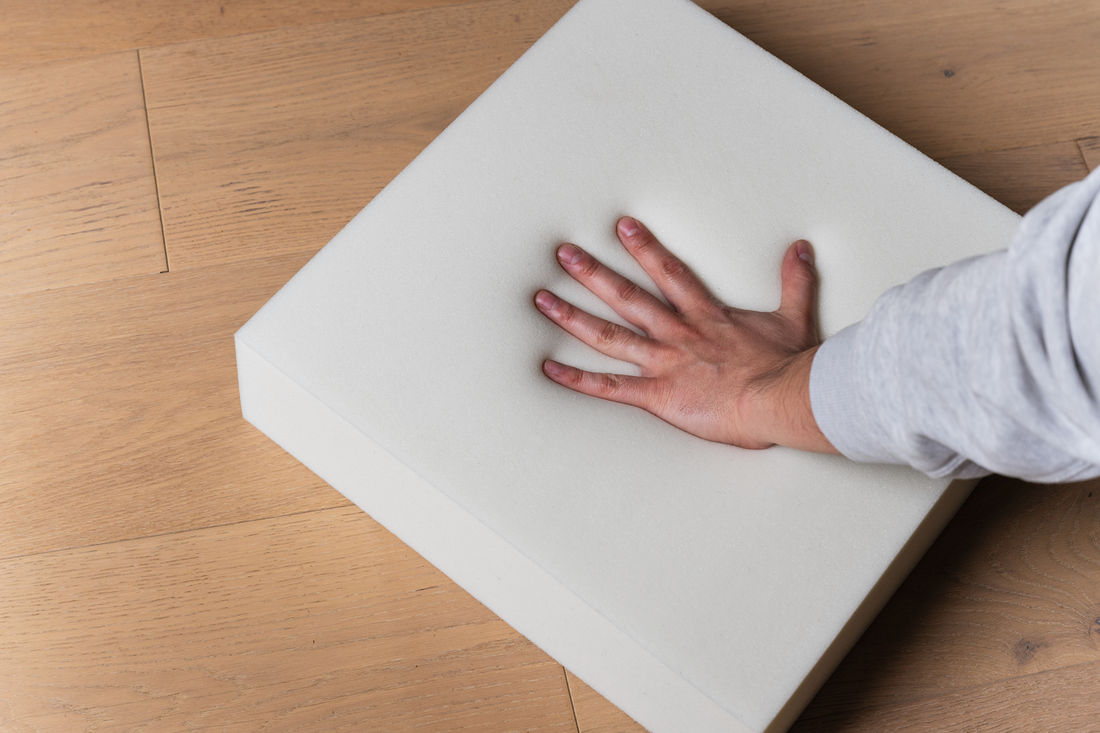Two of the most commonly used foams in furniture, bedding, automotive, and packaging are conventional polyurethane foam (PU foam) and viscoelastic polyurethane foam, better known as memory foam. While both start with similar base materials, their properties, applications, and overall performance vary. At Envirolite, we supply all types of foam to all industries—so we’re here to break down the key differences and help you make the best choice for your needs.
What Is Memory Foam?
Memory foam, also referred to as viscoelastic polyurethane foam, is a specialized type of polyurethane that has been engineered for enhanced viscosity and elasticity. This means that, unlike standard PU foam, memory foam responds slowly to pressure and heat. When you lie on it, memory foam softens, contours to the shape of your body, and evenly distributes weight. Once you get up, it gradually returns to its original form—hence the term “slow-recovery” foam.
This unique ability to adapt to your shape makes memory foam a popular choice in products designed for comfort and support. You’ll often find it in mattresses, pillows, orthopedic cushions, and even in medical devices like wheelchair seating and hospital beds. It’s also used in footwear to improve pressure distribution and reduce impact.
What Is PU Foam?
Polyurethane foam, or PU foam, is the standard and highly versatile cousin of memory foam. It’s made by combining polyols and diisocyanates in a chemical reaction, resulting in a lightweight and flexible material that can be manufactured in a wide range of densities and firmness levels. Unlike memory foam, PU foam doesn’t conform to your body or respond to temperature. Instead, it offers consistent support and cushioning regardless of how or where you use it.
Thanks to its affordability and adaptability, PU foam is used almost everywhere—from sofa cushions and mattresses to car seats, office chairs, and protective packaging. Its lighter weight also makes it ideal for applications where ease of movement and cost-effectiveness are top priorities.
Key Differences Between Memory Foam and PU Foam
The core difference between memory foam and PU foam lies in their composition and behavior. While both are polyurethane-based, memory foam contains added chemicals that give it its viscoelastic properties. These chemical enhancements allow memory foam to contour and respond to body heat, creating a personalized feel that standard PU foam doesn’t offer.
Comfort is another major point of contrast. Memory foam is known for its pressure-relieving properties, making it ideal for people with joint pain or those who need ergonomic support. PU foam, on the other hand, offers more generalized support. It doesn’t mold to your body, but it does provide reliable cushioning and structure.
Durability also varies between the two. Memory foam, due to its denser composition, typically lasts longer and retains its shape better over time. PU foam, especially in lower densities, may break down more quickly and lose its firmness. Another difference is in temperature sensitivity—memory foam softens with body heat, while PU foam remains unaffected by temperature changes.
In terms of cost, PU foam is generally the more budget-friendly option. It’s less expensive to produce and widely available, making it a go-to for mass-produced furniture and products. Memory foam, with its enhanced features and performance, tends to come at a higher price point.
Pros, Cons, and Use Cases
Memory foam is a top choice when comfort and support are the primary goals. Its ability to contour to your body helps alleviate pressure points, making it ideal for mattresses, pillows, and medical applications. It also does a great job minimizing motion transfer, which is a huge plus for couples sharing a bed. However, memory foam isn’t without drawbacks. It tends to retain heat, which can be uncomfortable for hot sleepers, and it’s often heavier and more expensive than PU foam.
PU foam shines in applications where flexibility, cost-efficiency, and ease of use are important. It’s widely used in furniture like sofas and recliners, in automotive seating, and in protective packaging materials. It’s lightweight, easy to move, and customizable in firmness. That said, it doesn’t provide the same contouring or long-term durability as memory foam and may lose its shape more quickly with heavy use.
Choosing the Right Foam for Your Needs
So, which foam should you choose? If your focus is on comfort, pressure relief, or reducing movement disturbance—especially in bedding or medical contexts—memory foam is likely the better option. It’s particularly helpful for individuals dealing with chronic pain or for those looking to improve sleep quality. If you’re working within a budget or need a more lightweight and flexible material for furniture or general-purpose use, PU foam is a smart, practical choice. It’s also ideal for projects where ease of transport and installation are key concerns.
Environmental Considerations
Both memory foam and PU foam are made from synthetic materials, so their environmental impact is something to keep in mind. However, advancements in foam production are making strides toward sustainability. Some memory foams now incorporate plant-based oils to reduce their reliance on petroleum-based inputs, and both types of foam can be recycled under the right conditions. At Envirolite, we continue to explore eco-friendly foam options and work with clients who are focused on sustainable design.
Final Thoughts
Whether you’re designing a luxury mattress, building ergonomic seating, or looking for economical foam for a furniture line, knowing the difference between conventional polyurethane and memory foam can make a big impact. Each has its own strengths and trade-offs, and the best choice depends on your project’s unique goals and constraints.
At Envirolite, we provide every type of foam to suit every kind of application. Not sure which one is right for you? Get in touch with us—we’re happy to guide you through the options and help you find the perfect solution for your needs.

